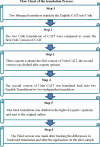Urdu translation and cross-cultural validation of Cumberland Ankle Instability Tool (CAIT)
- PMID: 35549689
- PMCID: PMC9097047
- DOI: 10.1186/s12891-022-05408-4
Urdu translation and cross-cultural validation of Cumberland Ankle Instability Tool (CAIT)
Abstract
Background: The Cumberland Ankle Instability Tool (CAIT) is a self-assessment tool for people with chronic ankle instability (CAI). This tool had been translated and validated in many languages but there is no Urdu version of CAIT available.
Objective: The aim was to translate the CAIT into the Urdu Language and determine its validity and reliability.
Methods: A standardized step-wise forward and backward translation process was followed. Content, construct, convergent validity, internal consistency, and test-retest reliability were determined. A pilot study was done on 10 patients with CAI. The final version was investigated in 120 patients (mean age 26.6 ± 4.8 yrs) with CAI for validity and test-retest reliability in which 105 participants filled the questionnaire in the second week. Internal consistency was calculated by Cronbach's alpha. Intraclass correlation (ICC2,1) was calculated to assess test-retest reliability between two weeks. Standard error of measurement (SEM) and smallest detectable change (SDC) were calculated. Convergent validity was determined by correlating Urdu CAIT with the Foot and Ankle Outcome Score (FAOS) using Spearman's correlation co-efficient. Factor analysis describes the structure of underlying factors.
Results: Content validity index was > 0.80 of each question. Internal consistency was acceptable (Cronbach's alpha > 0.75). Convergent validity with FAOS total score showed a moderate negative correlation (r = -0.68) with U-CAIT and negatively correlated with subscales of FAOS. Test-retest reliability was excellent ICC2,1 > 0.80. Scree plot showed 3 factors > 1eigen value.
Conclusion: The Urdu version of CAIT is a valid and reliable assessment tool for patients with chronic ankle instability. It has good content validity, construct validity and reliability.
Keywords: Ankle instability; CAIT; Intraclass correlation; Reliability; Validity.
© 2022. The Author(s).
Conflict of interest statement
The authors declare that they have no competing interests.
Figures
Similar articles
-
Assessing Functional Ankle Instability in Sport: A Critical Review and Bibliometric Analysis.Healthcare (Basel). 2024 Aug 30;12(17):1733. doi: 10.3390/healthcare12171733. Healthcare (Basel). 2024. PMID: 39273757 Free PMC article. Review.
-
Cross cultural adaptation, reliability and validity of the Polish version of the Cumberland Ankle Instability Tool.Disabil Rehabil. 2024 Jun;46(13):2926-2932. doi: 10.1080/09638288.2023.2232719. Epub 2023 Jul 18. Disabil Rehabil. 2024. PMID: 37463065
-
Cross-cultural adaptation, reliability, and validity of the Turkish version of the Cumberland Ankle Instability Tool.Musculoskelet Sci Pract. 2023 Nov;68:102873. doi: 10.1016/j.msksp.2023.102873. Epub 2023 Oct 20. Musculoskelet Sci Pract. 2023. PMID: 37897935
-
The Cumberland Ankle Instability Tool (CAIT) in the Dutch population with and without complaints of ankle instability.Knee Surg Sports Traumatol Arthrosc. 2018 Mar;26(3):882-891. doi: 10.1007/s00167-016-4350-4. Epub 2016 Oct 6. Knee Surg Sports Traumatol Arthrosc. 2018. PMID: 27714439 Free PMC article.
-
Cross-Cultural Instrument Adaptation and Validation of Health Beliefs About Cancer Screening: A Methodological Systematic Review.Cancer Nurs. 2022 Sep-Oct 01;45(5):387-396. doi: 10.1097/NCC.0000000000001007. Epub 2021 Sep 3. Cancer Nurs. 2022. PMID: 34483286
Cited by
-
Cross-Cultural Adaptation and Cutoff Score Determination of the Turkish Version of the Cumberland Ankle Instability Tool in Recreationally Active Individuals.Orthop J Sports Med. 2025 Aug 19;13(8):23259671251358407. doi: 10.1177/23259671251358407. eCollection 2025 Aug. Orthop J Sports Med. 2025. PMID: 40843095 Free PMC article.
-
The effect of Tuina based on the concept of hip-knee-ankle conjugation in patients with chronic ankle instability: study protocol for a randomized controlled trial.Front Rehabil Sci. 2023 Aug 25;4:1165548. doi: 10.3389/fresc.2023.1165548. eCollection 2023. Front Rehabil Sci. 2023. PMID: 37691913 Free PMC article.
-
Ankle biomechanics of the three-step layup in a basketball player with chronic ankle instability.Sci Rep. 2023 Oct 31;13(1):18667. doi: 10.1038/s41598-023-45794-w. Sci Rep. 2023. PMID: 37907629 Free PMC article.
-
Assessing Functional Ankle Instability in Sport: A Critical Review and Bibliometric Analysis.Healthcare (Basel). 2024 Aug 30;12(17):1733. doi: 10.3390/healthcare12171733. Healthcare (Basel). 2024. PMID: 39273757 Free PMC article. Review.
References
MeSH terms
LinkOut - more resources
Full Text Sources




